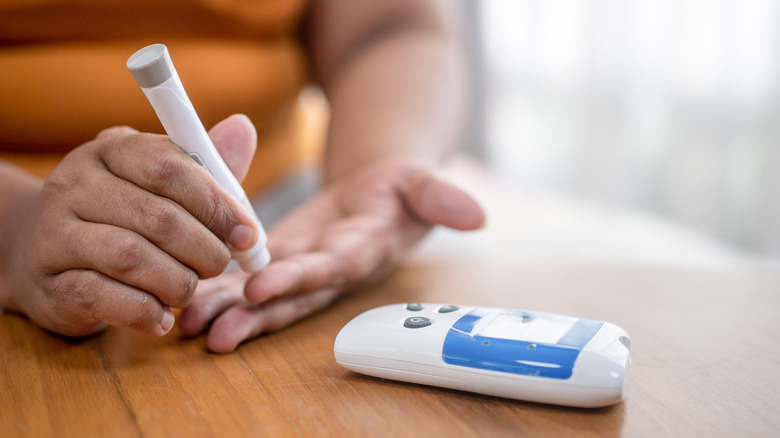Blood Sugar Warning Signs You Shouldn't Ignore If You're Over 50
Each time you eat something, your body goes to work sorting out the nutrients to fuel and heal your body. Carbs in your food are converted to glucose to provide energy for your cells. That's when your blood sugar rises, so your pancreas begins to release insulin to cue your cells to absorb this energy source.
As you get older, your pancreas becomes less effective at producing and secreting insulin, so it might take a little longer for your blood sugar to return to normal. This might produce alarming symptoms such as fatigue, loss of focus, lightheadedness, and frequent urination, said Dr. Amy Lee, Head of Nutrition for Nucific, in an interview with Health Digest. "Less common symptoms of someone dealing with an imbalance of sugar can be anything, but I have come across complaints of heart palpitations and headaches for both low and high sugars," she said.
You might attribute these signs to general aging, but type 2 diabetes can develop slowly. Other signs your blood sugar might be spiking could be increased thirst, weight loss, blurred vision, or slow healing of cuts. "I think in most cases, people do feel some level of discomfort which should prompt them to have a check-up," Lee said. "A good thing to do is have a typical annual check-up with one's doctor which includes screening for potential issues of these risk factors." You could run into serious complications if your type 2 diabetes isn't diagnosed and treated.
What happens if you don't manage blood sugar
A medical professional can check your A1C levels, which is an indicator of your average blood sugar over a few months. The American Diabetes Association says that an A1C level of 6.5% or higher indicates type 2 diabetes, and between 5.7 and 6.5 is considered prediabetes. You might need to take medication to control your diabetes and keep track of your glucose. You can also control your blood sugar through diet and exercise.
If you don't have your blood sugar under control, you could develop eye, kidney, nerve, feet, and heart damage. You might also lose your brain's executive function, according to a 2012 study in Aging & Mental Health. In a survey of more than 500 rural older adults with diabetes, the lower a person's A1C level, the higher the person's ability to handle everyday tasks and solve problems. Type 2 diabetes increases your risk for a subcortical stroke, and a 2011 study in Diabetes Cares found that people with untreated diabetes were 2.6 times more likely to have this type of stroke.
Risk factors for type 2 diabetes over 50
Just because you're getting older doesn't mean type 2 diabetes is imminent. Other factors can influence your blood sugar as you age, according to a 2017 article in Diabetes Care. You tend to lose muscle as part of the aging process, and this loss of muscle mass can contribute to your insulin resistance. Your body can become insulin-resistant if you gain more weight, particularly around your abdomen.
Other chronic conditions can raise your risk of developing diabetes. High blood pressure and certain medications can increase insulin resistance. Additionally, conditions like arthritis or depression may lead to a sedentary lifestyle, making it harder to manage blood sugar levels.
Only 12% of older adults engage in regular exercise, according to the study. However, exercise can reduce insulin resistance and the risk of diabetes. For people with type 2 diabetes, exercise can keep your blood sugar under control. Whether you have type 2 diabetes or not, you can help manage your blood sugar by consuming less sugar in your diet. That means nixing those sugar-sweetened drinks, desserts, and processed foods.


